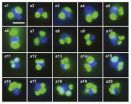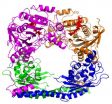(Press-News.org) A team of biologists has discovered an entirely new group of algae living in a variety of marine and freshwater environments. This group of algae, which the researchers dubbed "rappemonads," have DNA that is distinctly different from that of other known algae. In fact, humans and mushrooms are more closely related to each other than rappemonads are to some other common algae (such as green algae). Based on their DNA analysis, the researchers believe that they have discovered not just a new species or genus, but a potentially large and novel group of microorganisms.
The rappemonads were found in a wide range of habitats, in both fresh and salt water, and at temperatures ranging from 52 degrees to 79 degrees Fahrenheit. According to MBARI Senior Research Technician Sebastian Sudek, co-first author of the paper reporting the discovery of these algae, "Based on the evidence so far, I think it's fair to say that rappemonads are likely to be found throughout many of the world's oceans. We don't know how common they are in fresh water, but our samples were not from unusual sources—they were from small lakes and reservoirs."
Researchers Sebastian Sudek, Heather Wilcox, and Alexandra Worden of the Monterey Bay Aquarium Research Institute (MBARI), along with collaborators at Dalhousie University and the Natural History Museum (NHM), London, discovered these microscopic algae by following up on an unexpected DNA sequence listed in a research paper from the late 1990s. They named the newly identified group of algae "rappemonads" after Michael Rappé a professor at the University of Hawaii, who was first author of that paper.
Following up on their initial lead, the research team developed two different DNA "probes" that were designed to detect the unusual DNA sequences reported by Rappé. Using these new probes, the researchers analyzed samples collected by Worden's group from the Northeast Pacific Ocean, the North Atlantic, the Sargasso Sea, and the Florida Straits, as well as samples collected from several freshwater sites by co-author Thomas Richards' group at NHM. To the teams' surprise, they discovered evidence of microscopic organisms containing the unusual DNA sequence at all five locations.
Although the rappemonads were fairly sparse in many of the samples, they appear to become quite abundant under certain conditions. For example, water samples taken from the Sargasso Sea near Bermuda in late winter appeared to have relatively high concentrations of rappemonads.
When asked why these apparently widespread algae had not been detected sooner, Sudek speculates that it may in part be due to their size. "They are too small to be noticed by people who study bigger algae such as diatoms, yet they may be filtered out by researchers who study the really small algae, known as picoplankton."
Sudek says, "The rappemonads are just one of many microbes that we know nothing about—this makes it an exciting field in which to work." Worden, in whose lab the research was conducted, and who first noticed the unique sequence in the 1990 paper then initiated research to "chase down" the story behind that sequence, continues, "Right now we treat all algae as being very similar. It is as if we combined everything from mice up to humans and considered them all to have the same behaviors and influence on ecosystems. Clearly mice and humans have different behaviors and different impacts!"
Even though DNA analysis demonstrated that rappemonads were present in their water samples, the researchers were still unable to visualize the tiny organisms because they didn't know what physical characteristics to look for. However, by attaching fluorescent compounds to the newly developed DNA probes, and then applying these probes to intact algae cells, Eunsoo Kim at Dalhousie was able to make parts of the rappemonads glow with a greenish light. This allowed the researchers to see individual rappemonads under a microscope.
The greenish glow highlighted the rappemonad's "chloroplasts," which contain the unique DNA sequence tagged by the new probes. Chloroplasts are used by plants and algae to harvest energy from sunlight in a process called photosynthesis. Because all of the rappemonads contain chloroplasts, the researchers believe they "make a living" through photosynthesis. However, Worden points out that it still needs to be shown that the chloroplasts are functional.
One of the primary goals of Worden's research is to study marine algae in the context of their environment. Worden feels that such an approach is imperative to understanding how rappemonads and other microorganisms affect large-scale processes in the ocean and in the atmosphere. In coming years her lab will be building upon their recent insights, including the discovery of the rappemonads, to study the roles that different algal groups play in the cycling of carbon dioxide between the atmosphere and the ocean.
Worden says, "There is a tremendous urgency in gaining an understanding of biogeochemical cycles. Marine algae are key players in these cycles, taking up carbon dioxide from the atmosphere and releasing oxygen, which we breathe. Until we have a true census of marine algae and understanding of how each group thrives, it will be very difficult to model global biogeochemical cycles. Such modeling is essential for predicting how climate change will impact life on earth."
INFORMATION:
This release can be viewed online at:
http://www.mbari.org/news/news_releases/2011/rappemonads/rappemonads-release.html
For images related to this release, please see:
http://www.mbari.org/news/news_releases/2011/rappemonads/rappemonads-images.html
Newly discovered group of algae live in both fresh water and ocean
May have worldwide distribution
2011-01-21
ELSE PRESS RELEASES FROM THIS DATE:
Red blood cell hormone modulates the immune system
2011-01-21
New research reveals that a hormone best known for stimulating the production of red blood cells can modulate the immune response. The study, published by Cell Press in the January 27th issue of the journal Immunity, finds that erythropoietin (EPO) has contrasting influences on infectious and inflammatory diseases and may be useful in the design of new therapeutic strategies.
EPO is a cytokine hormone that stimulates the production of red blood cells by acting at EPO receptors (EPORs) on red blood cell precursors. Interestingly, other cell types also express EPORs. ...
Controlling symptoms can lead to improved quality of life for end-of-life patients
2011-01-21
LOUISVILLE, Ky. – Healthcare workers can most directly affect quality of life (QOL) of patients with advanced stage lung cancer by helping manage symptoms such as pain, lack of energy, shortness of breath, coughing, difficulty sleeping and dry mouth, according to a study recently published in the journal Oncology Nursing Forum.
Understanding the symptoms, particularly symptom distress - or the degree to which a symptom bothers a person, is crucial to improved patient care. Intervention at the time of diagnosis is important because patients with stage IIIb or IV lung cancer ...
Go figure: Math model may help researchers with stem cell, cancer therapies
2011-01-21
The difficult task of sorting and counting prized stem cells and their cancer-causing cousins has long frustrated scientists looking for new ways to help people who have progressive diseases.
But in a development likely to delight math teachers, University of Florida researchers have devised a series of mathematical steps that accomplishes what the most powerful microscopes, high-throughput screening systems and protein assays have failed to do — assess how rapidly stem cells and their malignant, stemlike alter egos increase their numbers.
The method, published in the ...
How the hat fits: Structural biology study reveals shape of epigenetic enzyme complex
2011-01-21
To understand the emerging science of epigenetics—a field that describes how genes may be regulated without altering the underlying DNA itself—scientists are deciphering the many ways in which enzymes act on the proteins surrounding DNA within cells.
One type of these enzymes, proteins known as histone acetyltransferases (HATs), act on DNA by modifying DNA-bound proteins called histones. This act of modification, called acetlyation, can dictate how histones interact with DNA and other proteins affecting processes such as DNA replication, transcription (reading the gene), ...
State of the Union 2011: Will President Obama commit to R&D, for jobs and economic growth?
2011-01-21
Research!America's chair, former Congressman John E. Porter (R-IL), and Research!America's CEO, Mary Woolley, issued the following statement in anticipation of President Barack Obama's State of the Union address.
Porter said, "I think the president understands that science, technology, innovation and research are where we lead the world and where we must make the ongoing investments to maintain that leadership. But he must, both in his State of the Union speech next Tuesday night and in the Budget he submits to Congress, make the case to both the American people and ...
NASA prepares to launch next Earth-observing satellite mission
2011-01-21
WASHINGTON -- NASA's newest Earth-observing research mission is nearing launch. The Glory mission will improve our understanding of how the sun and tiny atmospheric particles called aerosols affect Earth's climate. Glory also will extend a legacy of long-term solar measurements needed to address key uncertainties about climate change.
Glory is scheduled to launch from Vandenberg Air Force Base in California on Feb. 23 at 5:09 a.m. EST. It will join a fleet called the Afternoon Constellation or "A-train" of satellites. This group of other Earth-observing satellites, including ...
Swift survey finds 'missing' active galaxies
2011-01-21
Seen in X-rays, the entire sky is aglow. Even far away from bright sources, X-rays originating from beyond our galaxy provide a steady glow in every direction. Astronomers have long suspected that the chief contributors to this cosmic X-ray background were dust-swaddled black holes at the centers of active galaxies. The trouble was, too few of them were detected to do the job.
An international team of scientists using data from NASA's Swift satellite confirms the existence of a largely unseen population of black-hole-powered galaxies. Their X-ray emissions are so heavily ...
Gulf grows between research practice and participant preferences in genetic studies
2011-01-21
Obtaining consent for genetic studies can be an opportunity for researchers to foster respectful engagement with participants, not merely to mitigate legal risk. This shift is proposed in a policy forum appearing tomorrow, Jan. 21, in Science, the journal of the American Academy for the Advancement of Science.
The authors of the article, "Research Practices and Participant Preferences: The Growing Gulf" recommend new approaches that treat participants as true stakeholders in research, who willingly take on risks because they believe the potential benefits to society ...
Cell binding discovery brings hope to those with skin and heart problems
2011-01-21
A University of Manchester scientist has revealed the mechanism that binds skin cells tightly together, which he believes will lead to new treatments for painful and debilitating skin diseases and also lethal heart defects.
Professor David Garrod, in the Faculty of Life Sciences, has found that the glue molecules bind only to similar glue molecules on other cells, making a very tough, resilient structure. Further investigation on why the molecules bind so specifically could lead to the development of clinical applications.
Professor Garrod, whose Medical Research Council-funded ...
Friends of the UN Announces "2011 Tolerance Awardees" at United Nations Youth Assembly Friday January 21,2011
2011-01-21
Friends of the UN Announces 2011 Tolerance Awardees:
Honors Dr. Judy Kuriansky with 2011 Lifetime Achievement in Global Peace and Tolerance,
Nejeed Kassam as first Youth Ambassador
H/U/M and FOTUN Launches Tolerance Awareness Campaign, "Wear My Hat" with Awards
U.N. Ceremony streams live on The Huntington Buzz (www.HuntingtonBuzz.tv)
New York, NY 1/21/11 - Dr. Noel Brown, President of Friends of the United Nations (FOTUN) announces that as Friends of the UN grows to become the world's largest and most connected community of global citizens working to support ...
LAST 30 PRESS RELEASES:
Scientists boost cell "powerhouses" to burn more calories
Automatic label checking: The missing step in making reliable medical AI
Low daily alcohol intake linked to 50% heightened mouth cancer risk in India
American Meteorological Society announces Rick Spinrad as 2026 President-Elect
Biomass-based carbon capture spotlighted in newly released global climate webinar recording
Illuminating invisible nano pollutants: advanced bioimaging tracks the full journey of emerging nanoscale contaminants in living systems
How does age affect recovery from spinal cord injury?
Novel AI tool offers prognosis for patients with head and neck cancer
Fathers’ microplastic exposure tied to their children’s metabolic problems
Research validates laboratory model for studying high-grade serous ovarian cancer
SIR 2026 delivers transformative breakthroughs in minimally invasive medicine to improve patient care
Stem Cell Reports most downloaded papers of 2025 highlight the breadth and impact of stem cell research
Oxford-led study estimates NHS spends around 3% of its primary and secondary care budget on the health impacts of heat and cold in England
A researcher’s long quest leads to a smart composite breakthrough
Urban wild bees act as “microbial sensors” of city health.
New study finds where you live affects recovery after a hip fracture
Forecasting the impact of fully automated vehicle adoption on US road traffic injuries
Alcohol-related hospitalizations from 2016 to 2022
Semaglutide and hospitalizations in patients with obesity and established cardiovascular disease
Researchers ‘listen in’ to embryo-mother interactions during implantation using a culture system replicating the womb lining
How changing your diet could help save the world
How to make AI truly scalable and reliable for real-time traffic assignment?
Beyond fragmented markets: A new framework for efficient and stable ride-pooling
Can shape priors make road perception more reliable for autonomous driving?
AI tracks nearly 100 years of aging research, revealing key trends and gaps
Innovative techniques enable Italy’s first imaging of individual trapped atoms
KIER successfully develops Korea-made “calibration thermoelectric module” for measuring thermoelectric device performance
Diversifying US Midwest farming for stability and resilience
Emphasizing immigrants’ deservingness shifts attitudes
Japanese eels, climate change, and river temperature
[Press-News.org] Newly discovered group of algae live in both fresh water and oceanMay have worldwide distribution




